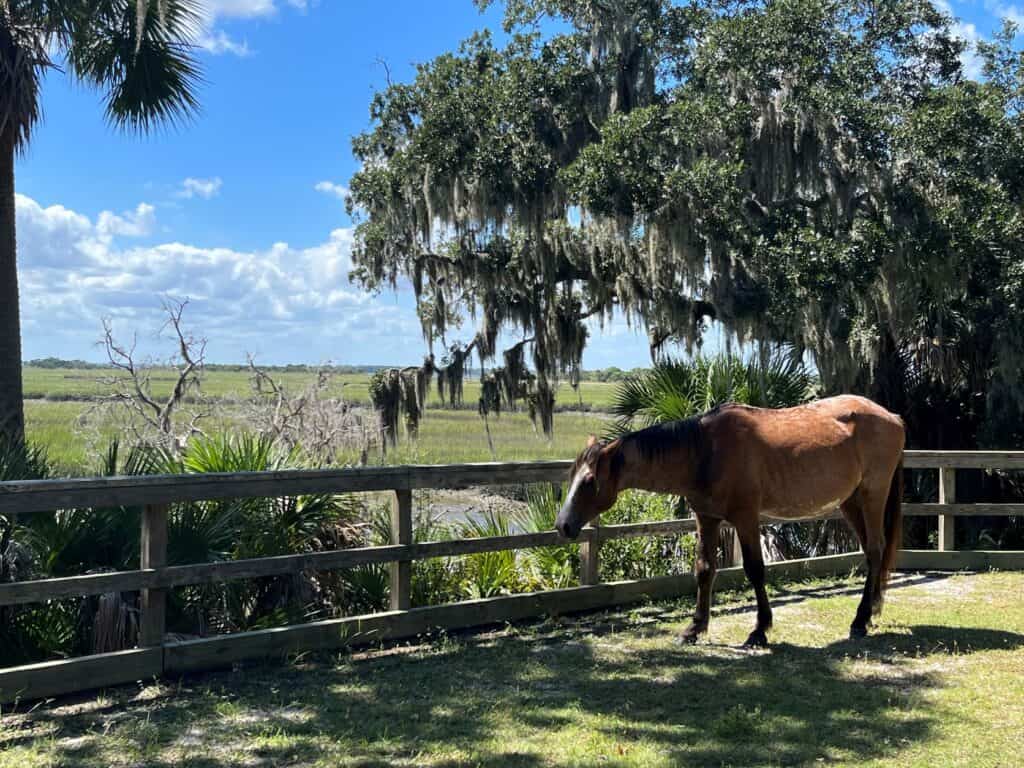A Golden Anniversary: Cumberland Island National Seashore
Florence “Floss” Carnegie Perkins was the seventh-born child of Lucy and Thomas Carnegie, brother of steel magnate Andrew. In 1901, she was married on the steps of the family’s Dungeness Mansion on Cumberland Island and spent the next decades raising her three children at New York’s Plaza Hotel. By the 1920s she relocated to Cumberland to reside at The Grange, the former overseer’s home, reportedly to shelter her alcoholic son, who landed in a Fernandina jail so often that she paid to remodel its cells. Her husband Frank died within a few years of their return to the island. Afterwards, Floss would invite her visiting grandnieces and -nephews to “see my husband.” He was in an urn on the mantelpiece. She watched as Dungeness burned on June 24, 1959, weeping uncontrollably. Family members say the house’s destruction caused her to lose her gusto for life. In 1962 at the age of 82, she died of cancer. Floss’s passing freed the Carnegie descendants of Lucy Carnegie’s ironclad trust, which prohibited her children from dividing their island property until the last sibling’s death. This set Cumberland Island on a tortuous path which resulted in its national park designation fifty years ago.
Upon Floss’s death, heated debate arose among the Carnegie descendants over what to do with their Cumberland tracts. Many wished to sell their land or exploit its natural resources for profit, but most desired to keep their precious ancestral land intact. As early as 1950 the island’s beauty and rich history drew the interest of the federal government. The family was attracted to Cumberland’s becoming a national park, as they believed they could sell their land to the government and still retain their island homes.
However, not all family members agreed. In 1968, half-brothers Thomas Carnegie IV and Andrew Carnegie III sold their 3,100 acres to Charles Fraser – creator of fashionable Sea Pines Plantation on Hilton Head Island – for $1.5 million. His plans for Cumberland were similar to his Hilton Head development: here at “Cumberland Oaks,” Fraser would construct marinas, hotels, brightly-colored tiki bars and hot tubs on the beach, manicured golf courses surrounded by expensive subdivisions, and an airport large enough to support corporate jets. By February 1969, he had set up his Cumberland headquarters (today’s “Sea Camp”) and was supervising bulldozers’ uprooting the island’s lush forest for an airport.
Upon hearing this news, the Carnegie descendants were incensed. Not only was their island threatened, but they thoroughly disliked Fraser, who admittedly was not very personable. According to one story, Fraser was invited to dinner at Greyfield Inn where Edith Ferguson, its proprietress and a Carnegie descendant, met him on the front porch and extended her hand in greeting. Instead of shaking her hand, Fraser laid his coat on her arm and proceeded inside.
The Carnegies (along with the Candlers of Coca Cola fame and owners of a northern portion of the island) were jolted into action. They pooled their resources to petition Congress to transform Cumberland into a national seashore. The family demanded strict guarantees: first that they retain their island homes as lifetime estates and then that the Park Service promise in writing not to develop or build a bridge to the island.
In 1970, billionaire philanthropist Paul Mellon heard of the dangers Cumberland faced and donated $5 million so that the National Park Service could make a bid for the island. Although some Carnegies refused to sell (the Fergusons of Greyfield being the most notable example), Fraser and several Carnegie family members sold a total of 8,300 acres to the park service.
On October 23, 1972, Congress passed a bill designating Cumberland a national seashore to “preserve the scenic, scientific, and historic character of the island.” Finally, the Carnegies achieved the goal they had pursued for over a decade. When the family sold or donated their Cumberland tracts, they entrusted Plum Orchard and twenty-five other historic structures to the government’s care. The National Park Service has continued accumulating land (including the Candlers’ tract) so that today it owns about 90 percent of the island.
As we celebrate Cumberland Island National Seashore’s fiftieth anniversary beginning in October, let us send a thought of thanks to those who helped create this park which contains the longest stretch of undeveloped beach on the Atlantic Coast, one of the largest Wilderness areas in the country, and 9,000 acres of pristine, fertile salt marsh. Cumberland Island belongs to all of us now, and that is something for which to be grateful.
Want more history of Cumberland Island? Join a Cumberland Island Walking Tour!



